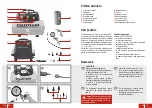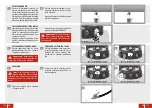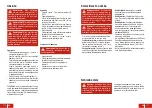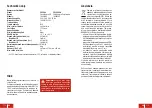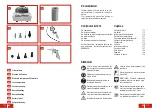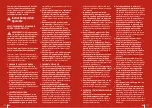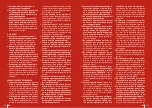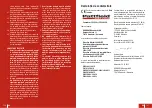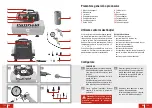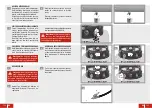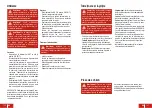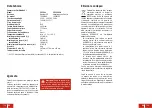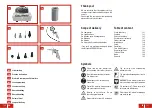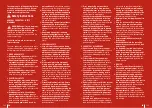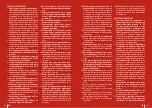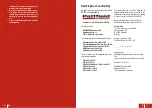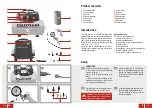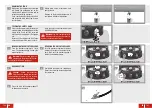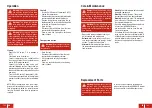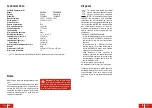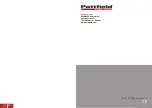
EN
134
EN
135
6 SPECIAL SAFETY RULES
1.
Know your air compressor. Read opera-
tion manual carefully.
Learn its applica-
tions and limitations, as well as the spe-
cific potential hazards related to this tool.
Following this rule will reduce the risk of
electric shock, fire, or serious injury.
2.
Drain tank of moisture after use each
day.
If unit will not be used for a while, it
is best to leave drain valve open until such
time as it is to be used. This will allow
moisture to completely drain out and help
prevent corrosion on the inside of tank.
3.
Risk of fire or explosion.
Do not spray
flammable liquids. Spray area must be well
ventilated. Keep compressor away from
the spraying area and all explosive vapors.
4.
Risk of bursting.
Do not adjust regulator
to result in output pressure greater than
marked maximum pressure of attachment
and/or the item being inflated. Never use at
pressure greater than 8 bar.
5.
Use an air pressure gauge periodically
while inflating an item to check the air
pressure.
6.
To reduce the risk of electric shock, do
not expose the machine to rain (water)
or dust; only store it indoors.
7.
Inspect tank yearly for rust, pin holes,
or other imperfections that could cause
it to become unsafe.
Never weld or drill
holes in the air tank.
8.
Make sure the hose is free of obstruc-
tions or snags.
Entangled or snarled hos-
es can cause loss of balance or footing and
may become damaged.
9.
Use the air compressor only for its in-
tended use.
Do not alter or modify the unit
from the original design or function.
10.
Always be aware that misuse and im-
proper handling of this tool can cause
injury to yourself and others.
11.
Never step or stand on the compressor.
Following this rule will reduce the risk of
serious personal injury.
12.
Never leave a tool unattended with the
coiled air hose attached.
13.
Do not operate this tool if it does not
contain a legible warning label.
14.
Do not continue to use a tool or hose
that leaks air or does not function prop-
erly.
15.
Always disconnect the power supply
and air supply before making adjust-
ments, servicing a tool, or when a tool
is not in use.
16.
Do not attempt to pull or carry the air
compressor by the hose.
17.
Your tool may require more air con-
sumption than this air compressor is
capable of providing.
18.
Always follow all safety rules recom-
mended by the manufacturer of your
air tool, in addition to all safety rules
for the air compressor.
Following this
rule will reduce the risk of serious personal
injury.
19.
Never direct a jet of compressed air to-
ward people or animals.
Take care not
to blow dust and dirt towards yourself or
others. Following this rule will reduce the
risk of serious injury.
20.
Do not use this air compressor to spray
chemicals.
Your lungs can be damaged by
inhaling toxic fumes. A respirator is neces-
sary in dusty environments or when spray-
ing paint.
21.
Inspect tool cords and hoses peri-
odically and, if damaged, have them
repaired at your nearest HORNBACH
Store.
Constantly stay aware of cord loca-
tion. Following this rule will reduce the risk
of electric shock or fire.
22.
Check damaged parts.
Before further
use of the air compressor or air tool, a
guard or other part that is damaged should
be carefully checked to determine that it
will operate properly and perform its in-
tended function.
23.
Check for alignment of moving parts,
binding of moving parts, breakage of
parts, mounting, and any other condi-
tions that may affect its operation.
A
guard or other part that is damaged should
be properly repaired or replaced by an au-
thorized service center. Following this rule
will reduce the risk of shock, fire, or seri-
ous injury.
24.
Make sure your extension cord is in
good condition.
When using an extension
cord, be sure to use one heavy enough to
carry the current your product will draw. A
wire gauge size at least 1 mm
2
is recom-
mended for an extension cord 7.6 m or less
in length. A cord exceeding 15 m is not rec-
ommended. If in doubt, use the next heav-
ier gauge. The smaller the gauge number,
the heavier the cord. An undersized cord
will cause a drop in line voltage, resulting
in loss of power and overheating.
25.
Do not use tool inside a garage.
Follow-
ing this rule will reduce the risk of igniting
fuel vapours.
26.
Never store tool with air connected.
Storing a tool with air connected can result
in unexpected firing and possible serious
personal injury.
27.
Protect your lungs.
Wear a face or dust
mask if the operation is dusty. Following
this rule will reduce the risk of serious per-
sonal injury.
28.
Do not operate coiled air hoses above
the rated pressure.
Following this rule
will reduce the risk of serious personal
injury.
29.
If the power supply cord is damaged, it
must be replaced only by the manufac-
turer or by an authorized service center
to avoid the risk of electric shock or
product malfunction..
30.
Save these instructions.
Refer to them
frequently and use them to instruct others
who may use this tool. If you loan someone
this tool, loan them these instructions also.
31. Avoid heavy loads on the pipe system by
using flexible hose connections to avoid
kinks.
32. Do not exceed the maximum inclination
given in section “Technical Data”.
33. Do not use the machine in wet or humid
conditions.
34. Hoses connected to an air valve should be
fitted with a safety wire (e.g. a wire rope)
for operating pressures above 7 bars.
35. Do not use the machine in wet or humid
conditions.
36. While application in conjunction with spray
accessories (e. g. paint spray gun): Keep
distance to the appliance while filling spray
equipment and never spray into direction
of compressor.
ELECTRICAL CONNECTION
1.
This tool should be connected to a
power supply that is 220-240 V AC only
(normal household current), 50 Hz.
The power supply must have an over-
current protection in conformity with
the local installation regulations (max.
16 A).
Do not operate this product on direct
current (DC). A substantial voltage drop
will cause a loss of power and the motor
will overheat. If the air compressor does
not operate when plugged into an outlet,
double check the power supply.
2.
For voltage, the wiring in a building is
as important as the power rating of the
motor.
A line intended only for lights can-
not properly carry a power tool motor. Wire
that is heavy enough for a short distance
will be too light for a greater distance. A
line that can support one power tool may
not be able to support two or three tools.
3.
This product must be grounded.
In the
event of a malfunction or breakdown,
grounding provides a path of least resist-
ance for electric current to reduce the risk
of electric shock. This tool is equipped
with an electric cord having an equipment-
grounding conductor and a grounding plug.
The plug must be plugged into a matching
outlet that is properly installed and ground-
ed in accordance with all local codes and
ordinances.
4.
Only connect the product to an outlet
having the same configuration as the
plug.
Do not use an adapter with this
product.
5.
Do not modify the plug provided.
If it will
not fit the outlet, have the proper outlet in-
stalled by a qualified electrician.
6.
Check with a qualified electrician or
service personnel if the connection
instructions are not completely under-

